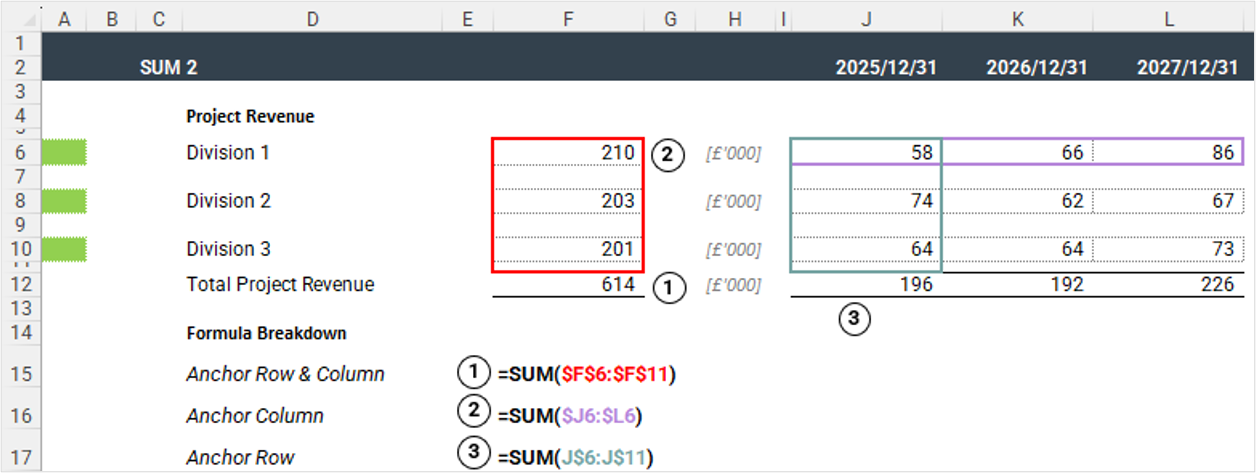SUM: The Foundation of Every Great Financial Model
59% of all excel formulas in high-quality financial models were driven by the SUM function based on the PPS analysis of 100 + best-practice models, 2019 – 2025.
The Excel SUM function is the most widely used formula across all types of financial models – and for good reason. It is not an advanced formula, but its dominance is no coincidence: simplicity is one of the five pillars of best-practice modelling.
At its core, SUM adds numbers together – an elegant alternative to long strings of “+” operators. Because it’s so simple, it’s the perfect vehicle to illustrate broader modelling disciplines such as anchoring, named ranges, and the Buffer-Row Method™ – small technical habits that make models more reliable, scalable, and auditable.

How to Use the SUM Function in Excel Financial Models

SUM can also combine multiple ranges or individual cells:

Where SUM Is Used in Financial Modelling
SUM runs through every layer of a model:
- Inputs: Aggregate raw assumptions or perform quick completeness checks. SUM is one of the few formulas acceptable on input sheets when used for validation.
- Calculations: Total revenue, operating costs, or control-account components.
- Checks: Confirm that subtotals reconcile: does the annual total equal the sum of monthly values? Do net assets equal total equity?
- Outputs & Summaries: Roll results into dashboards and decision-ready reports for investors or boards.
Function Frequency in Financial Models
SUM’s simplicity is its strength, but it’s often applied where a different formula would be more effective.
Whenever conditions are involved – such as summing by period, category, or flag – it’s time to move from SUM to SUMIFS, which we will review in our next article .
Best Practices for the Excel SUM Function in Financial Models
Anchor Intelligently
Anchoring controls whether a reference moves when formulas are copied. Write each formula once, then drag it.
If you want a column or row to stay fixed, use $:
=SUM($C5:$C10)

Avoid Full-Column References
Shortcuts like =SUM(A:A) force Excel to recalculate thousands of empty cells. In large models that’s a silent performance killer. When optimising Excel model performance, use precise ranges (e.g. =SUM(A5:A20)) and avoid volatile references.

Use the Buffer-Row Method™
A PPS hallmark technique. Insert a blank row between a data block and its total, and include that blank in the SUM range.
This approach keeps totals resilient as the model grows.
(See Pro Example below for a demonstration)
Position Totals Consistently
Place totals below or to the right of their inputs. A clear top-to-bottom or left-to-right flow makes models easier to follow and audit.
Common SUM Function Errors and Fixes in Excel Financial Models
- Manual additions: Typing =C5+C6+C7 instead of =SUM(C5:C7) is fragile and breaks when rows are inserted.
- Ambiguous labels: “Total” or “Sum” instead of “Total Revenue.”
- Out-of-date labels: Static text that no longer matches content. Use dynamic text: =”Total “&Block_Header

- Hidden rows: Summing over hidden data creates silent discrepancies.
- Inconsistent structure: Totals that differ across sheets complicate cross-checks and automation.
Advanced Example – How to Use the Buffer-Row Method™ for Error-Proof SUM Totals
Let’s see the Buffer-Row Method™ applied inside a real cost block.
Suppose your Operating Costs section will grow over time. A static SUM like =SUM(C5:C9) won’t include new rows.
By deliberately leaving a blank row (row 10) and referencing it –
=SUM(C5:C10)
– you future-proof the total. When new cost lines are added above the blank, Excel automatically expands the range.
Why it matters
- The buffer visually separates data from calculation – a subtle but powerful design cue in professional Excel models.
- Totals self-adjust as blocks expand.

Modellers Insight
When we audit a model, one of the first things we look for is a rogue SUM. A single = A1+B1+C1 instead of =SUM(A1:D1) tells me there may be structural issues.
Working with Other Excel Aggregation Functions
SUM is the base layer for aggregation. Other formulas extend its logic:
- SUMIF/SUMIFS – Adds conditional logic for categories, timelines, or flags.
- MAX / MIN + SUM – Applies caps or floors before aggregation.
- SUMPRODUCT – Handles weighted or matrix-based totals.
Together, these create a toolkit for financial model aggregation that balances simplicity with flexibility.
Key Takeaways
- SUM accounts for ≈ three-fifths of all formulas in best-practice models.
- Simple, universal, and essential – SUM is the quiet backbone of every great financial model.
- Use SUMIFS when conditions apply; SUMPRODUCT only when structure demands it.
- When SUM is overused, it’s not simplicity – it’s a sign your model’s structure needs tightening.
Next Up
SUMIFS – The Dynamic Aggregator Every Financial Modeller Should Master →
In closing
If your team’s Excel models contain inconsistent or opaque totals, PPS can help you standardise structure, speed, and accuracy through a Model Rebuild.
🧾 Footnote
Source: PPS analysis of anonymised professional financial models built between 2021 and 2025. Percentages reflect each function’s share among all unique formulas identified across the sample.
For syntax details, see Microsoft’s official Excel SUM documentation.



